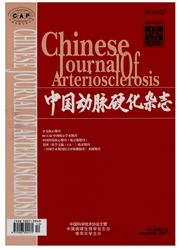

 中文摘要:
中文摘要:
目的研究沙利度胺对异常剪切应力诱导的兔颈总动脉粥样硬化病变形成的作用。方法新西兰兔分为3组,每组13只:正常饮食组、高脂组(给予2%高胆田醇饮食)和高脂加药组(2%高胆固醇饮食+20mg/kg沙利度胺)。39只新西兰兔均予以右颈总动脉硅胶管套环,套环长度为8mm,内径为1.4min。9周后处死动物,0周和第9周收集血清测量总胆固醇、低密度脂蛋白、高密度脂蛋白及甘油三酯等血脂指标水平。2个月后宰杀动物,取整条颈总主动脉行苏丹Ⅳ染色检测病变面积,HE染色检测病变的病变程度。结果0周和9周时三组动物体重差异没有显著性,一般体征无明显变化,表明动物对沙利度胺有很好耐受性。高脂组和高脂加药组总胆固醇、低密度脂蛋白、高密度脂蛋白及甘油三酯血清水平较对照组明显升高,高脂组和高脂加药纽血脂指标间差异无显著性。颈总动脉苏丹Ⅳ染色结果发现,高脂组远心段和近心段有明显的红染区域示动脉粥样硬化病变形成,且近心段动脉粥样硬化病变更加明显,狭窄段基本上没有动脉粥样硬化病变形成;高脂加药组主要在近心段有少量动脉粥样硬化病变存在;正常饮食组整条颈总动脉都无可见动脉粥样硬化病变。HE染色发现,高脂组近心段有明显的动脉粥样硬化病变存在,管腔明显狭窄,动脉粥样硬化病变中有大量的脂质蓄积和细胞浸润;高脂组套环段管壁明显变薄,无明显动脉粥样硬化病变存在;高脂组远心段动脉粥样硬化病变程度较近心段轻。高脂加药组仅在近心段有内膜增生病变存在。正常饮食组内膜无明显改变。结论剪切应力改变可以导致不同程度动脉粥样硬化病变的形成;沙利度胺对异常剪切应力诱导的兔颈总动脉粥样硬化病变的形成有抑制作用。
 英文摘要:
英文摘要:
Aim To study the effect of thalidomide on the atherosclerotic lesions induced by abnormal shear stress in the carotid arteries of New Zealand Rabbits. Methods After assembled silastic collars ( length 8 mm, intradiameter 1.4 mm) around the right carotid arteries of all the New Zealand White rabbits, they were randomly divided into three groups: control group (chew diet, n = 13 ), high-fat group (with 2% cholesterol, n = 13 ) and high-fat added with thalidomide (20 mg/kg) group. The rabbits were fed for 9 weeks. Serum was collected at the first week and the end week. Plasma triglyceride ( TG), total cholesterol (TC), high density lipoprotein ( HDL }, and low density lipoprotein (LDL} were determined by commercially enzymatic methods, the atherosclerotic lesions in carotid arteries were determined by using Sudan IV staining and HE staining. Results There was no obvious difference in body weight between three groups before and after experiment. Plasma TG, TC, LDL and HDL concentrations were markedly increased in high-fat group and high-fat added with thalidomide group compared with Control { P 〈 0.05 ). Compared with high-fat group, the content of TC, LDL, HDL and TG in high-fat added with thalidomide group had not statistical difference. Plaques were i- dentified to exist in the upstream from the cast obviously more than downstream from the cast in sizes in high-fat group with Sudan IV staining. The atheroselerotic lesions in high-fat added with thalidomide group existed in the upstream mainly, and the sizes were less than that in high-fat group. Compared with no atherosclerotic lesion in the cast, there were lipid accumulation and ceils infiltration in atherosclerotic lesions in high-fat group with HE staining, which extended to the lumina. The atherosclerotic lesions in the downstream existed with neointima formation. The main lesion in high-fat added with thalidomide group was neointima formation in the upstream, and no obvious lesion in downstream and the cast. There were no le
 同期刊论文项目
同期刊论文项目
 同项目期刊论文
同项目期刊论文
 期刊信息
期刊信息
